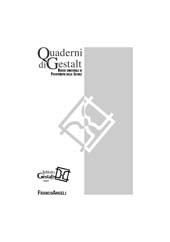Scrivere per elaborare il lutto : un contributo della psicoterapia della Gestalt
71-88 p.
Questo articolo propone una lettura in chiave gestaltica dell'ausilio della scrittura durante il processo di elaborazione del lutto, attraverso alcuni principi della psicoterapia della Gestalt (consapevolezza, sè;, creatività). Il lavoro sul lutto in psicoterapia della Gestalt consiste nel consegnare alla vita i beni relazionali maturati con la persona perduta. La scrittura e il terapeuta diventano custodi di un processo che facilita il passaggio dal dolore alla bellezza, intensificando e valorizzando in termini estetici l'elaborazione del lutto, assenza e presenza al tempo stesso. [Testo dell'editore]
This article is the result of an attempt to propose a reading of the role of writing in the mourning process. A brief theoretical introduction addresses the narrative approach in caregiving contexts, specifically during mourning. In Gestalt psychotherapy, the work of mourning involves bringing to life the relational legacy built with the lost person. It explores the experience of post-contact in a relationship, a moment of assimilation and growth. This process serves both as a map for orientation and a working tool for the therapist. Processing mourning means allowing the experience of loss to be shared, integrated into a relationship. It is a gradual process that requires time and care, unfolding on multiple levels simultaneously: temporal, spatial, and relational. From a phenomenological perspective, telling one's story and the story of a lost person allows for a deeper engagement with life's experiences and its dramas, adding value to one's existence
This process gives voice to the patient's need to rediscover him or herself through through a practical tool and a relational work model. The shared work aims not only to provide order and coherence but also to foster self-confidence. The clinical section of the article examines a model that offers the patient the strength needed not to become lost in the experience of mourning. Healing, therefore, begins when the past gives way to the present, and loneliness is replaced by the therapeutic relationship. The therapist becomes custodian of this path, intensifying and enriching the mourning process aesthetically: an experience in which absence and presence coexist. [Publisher's text]
-
Articles from the same issue (available individually)
-
Information
ISSN: 2035-6994
KEYWORDS
- Narrazione creatività elaborazione del lutto teoria del sé reciprocità
- narrative creativity grief theory of self reciprocity


